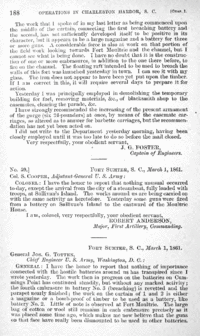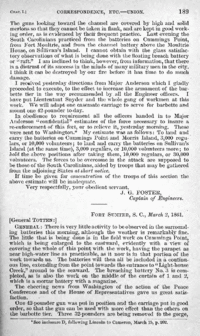From Warriors of the Rebellion
Jump to navigationJump to search
| March 1, 1861 - Captain John Foster to General Joseph Totten
|
 Click for full-sized scanned image  Click for full-sized scanned image Union Correspondence, etc.
FORT SUMTER, S.C., March 1, 1861.
General JOS. G. TOTTEN,
Chief Engineer U.S. Army, Washington, D.C.:
GENERAL: I have the honor to report that nothing of importance connected with the hostile batteries around us has transpired since I wrote yesterday. The work then in progress on the batteries on Cummings Point has continued steadily, but without any marked activity; the fourth embrasure in battery No. 3 [breaching] is reverted and the parapet nearly finished; the work on the curtain of 1 and 2 is either a magazine or a bomb-proof of timber to be used as a battery, like battery No. 2. Little of note is observed at Fort Moultrie. The large bag of cotton or wool still remains in each embrasure precisely as it was placed some time ago, which makes me now believe that the guns on the face have really been dismounted to be used in other batteries.
The guns looking toward the channel are covered by high and solid merlons so that they cannot be taken in flank, and are kept in good working order, as is evidenced by their frequent practice. Last evening the South Carolinians practiced from the batteries on Cummings Point, from Fort Moultrie, and from the channel battery above the Moultrie House, on Sullivan's Island. I cannot obtain with the glass satisfactory observations of what is being done with the floating breach battery or "raft." I am inclined to think, however, from information, that there is a distrust of its success in the minds of many military men in the city. I think it can be destroyed by our fire before it has time to do much damage.
I received yesterday direction from Major Anderson which I gladly proceeded to execute, to the effect to increase the armament of the barbette tier in the way recommended by all the Engineer officers. I have pour Lieutenant Snyder and the whole gang of workmen at this work. We will adapt one casemate carriage to serve for barbette and mount one 42-pounder to-day.
In obedience to requirement all the officers handed in to Major Anderson "confidential" estimates of the force necessary to insure a re-enforcement of this fort, or to relieve it, yesterday morning. These were sent to Washington.[1] My estimate was as follows: To land and carry the batteries on Cummings Point and Morris Island, 3,000 regulars, or 10,000 volunteers; to land and carry the batteries on Sullivan's Island [at the same time], 3,000 regulars, or 10,000 volunteers more; to hold the above positions after taking them, 10,000 regulars, or 30,000 volunteers. The forces to be overcome in the attack are supposed to be those the adjoining States at short notice.
If time be given for concentration of the troops of this section the above estimate will be inadequate.
Very respectfully, your obedient servant,
J.G. FOSTER,
Captain of Engineers.
(To view this page in its Source Category, click HERE for Part 1 and HERE for Part 2)
|